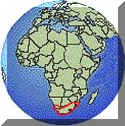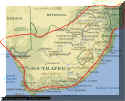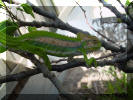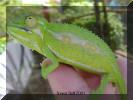Chamowners Web - Family Tree Pages
Bradypodion pumilum
KINGDOM: Animalia (animals)
PHYLUM: Cordata (chordates)
CLASS: Reptilia (reptiles)
ORDER: Squamata (scaled reptiles)
FAMILIES: snakes, warm lizards, lizards
LIZARD SUBFAMILY: Sauria
SAURIA INFRAORDER:
Anguimorpha (angid); Gekkota (gecko); Iguania (iguana); Scincomorpha (skink)
IGUANIA DIVISIONS:
Agamids; Iguanids; Chameleonids
CHAMAELEONIDAE FAMILY:
Subfamily Chamaeleoninae (True Chameleons)
Genus Bradypodion ("slow-footed")
Bradypodion pumilum
UNDERLINED TEXT IS LINKED TO A DEFINITION
IF THE TERM IN THE DEFINITION IS UNDERLINED IT IS LINKED TO AN ILLUSTRATION
| Distribution:
RSA, S. Mozambique, S. Nambia |
|
| Common Name | Cape Dwarf Chameleon |
| Name Translation | the dwarf |
| Synonyms | Chamaeleo pumilus pumilus |
| Discovered | Gmelin, 1789 |
| Size | small 20 - 25 cm or 8-10 inches |
| Sexual Dimorphism | The only noticeable difference is the hemipenal bulge in males. |
| Parity | ovoviviparous |
| Description | This species can display many different shades of yellow, brown, gray, black, green, blue, orange, pink, white, and red. The colors and markings vary within the species, but most have a longitudinal stripe or spots on the flank. They have a high casque with no occipital lobes, and the gular crest is made of skin flaps covered with scales. The lenticular scales on the flank contrast the surrounding skin. |
| Photo |
literature cited (1,2,5,6,7,8,9,17, 18)




_small.jpg)